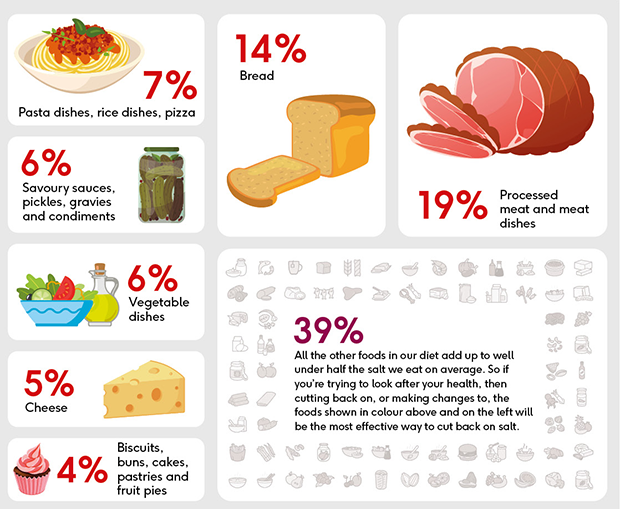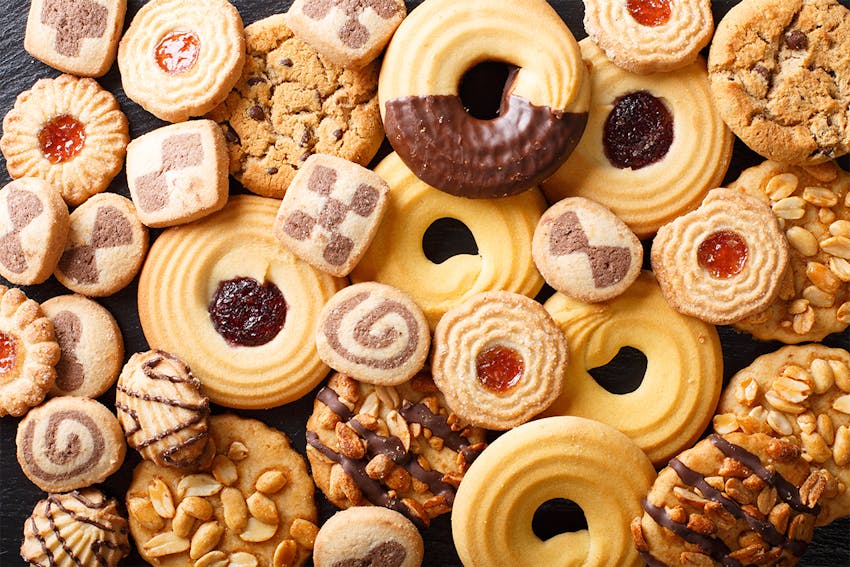Most of us eat too much salt, which is linked to high blood pressure, a risk factor for heart and circulatory diseases.
Although you might think you don’t need to worry about salt if you aren’t adding it during cooking or at the table, most of the salt we eat (up to 85%) is already in the foods we buy. So you could be eating more than you think. It’s recommended that we limit our daily salt intake to a maximum of 6g per day – about a teaspoon. But most of us are eating more than this.
The BHF wants to see more commitment from manufacturers and the government to continue reducing the amount of salt in foods. And there are things you can do, too. Here are seven foods to watch out for, with suggestions of how you can cut back:

1. Processed meat and meat dishes: 19%
Bacon, sausages, ham, meat pies, sausage rolls and other meat dishes are among the foods that are adding the most salt (and saturated fat, too) to our diet.
It’s also recommended that we cut down on processed meats to reduce our risk of cancer. You can do this by swapping ham sandwiches for tuna or egg sandwiches and swapping bacon or sausage in sandwiches or in a cooked breakfast for mushrooms or poached egg on toast.
2. Bread: 14%
Bread isn’t as high in salt as some foods, but most of us eat it often and so the amount of salt adds up.
Use the nutrition labels to compare bread products, and try to choose the one that’s lowest in salt (and also wholegrain). You can also reduce salt by swapping your breakfast toast for porridge, and lunchtime bread or toast for a jacket potato.
3. Pasta dishes, rice dishes and pizza: 7%
It’s not the pasta and rice themselves that are the problem, but the other things that go into these dishes: like salty sauces, processed meats, cheese, olives or anchovies. Making your own versions of these dishes means you can control how much salt you add as well as keeping a limit on salty additions like cheese, olives and anchovies.
4. Savoury sauces, pickles, gravies and condiments: 6%
These may seem like just a small addition, but they can end up adding a lot of salt to your meal. Try reduced-salt versions of tomato sauce, brown sauce or gravy granules. They might taste different at first, but stick with it and you’ll soon get used to the new flavour.
You can also make easy alternatives like tzatziki-style dip (mix low-fat plain yogurt, garlic and chopped or grated cucumber) or home-made houmous. Pickled vegetables like gherkins and onions can vary a lot in salt content, so check labels and choose the ones with the lowest salt. Try adding cherry tomatoes or radishes to your plate instead of pickles and chutneys, to add flavour.

5. Vegetable dishes: 6%
Plain, fresh vegetables are naturally low in salt, but some vegetable dishes may have salt added, like salads with ready-made dressings, baked beans, and some tinned vegetables. Make your own dressings, and choose reduced-salt baked beans and vegetables tinned in water.
Things like sun-dried tomatoes, olives, marinated artichokes, and mini peppers stuffed with cheese might seem like healthy Mediterranean foods, but are often salty. Use these sparingly, or make your own low-salt alternatives, like roasted or grilled peppers and courgettes.
6. Cheese: 5%
Cheddar is the source of more than half of the salt we get from cheese, because it’s the cheese we eat most of. Cheese does contain healthy nutrients like calcium and protein, so you don’t have to cut it out completely.
Try to limit your portion to 30g (1oz). Using a stronger-flavoured cheese and grating instead of slicing will help it go further. Skipping cheese as an added extra – for example, grated cheese on top of pasta or baked beans, or in a burger – can be a good place to start if you’re trying to cut down. Other sources of calcium that won’t come with added salt are low-fat milks, yogurt or fromage frais.

7. Biscuits, buns, cakes, pastries and fruit pies: 4%
Don’t assume that sweet foods won’t come with a salty surprise. Salt is often added to baked goods like biscuits, cakes and pastries – which also contain sugar and saturated fat, so there are lots of reasons to cut down.
Fresh fruit, a couple of dates, or a small handful of unsalted nuts and dried fruit would make a healthier sweet treat and will help you cut down on salt.








